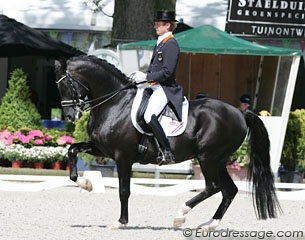
Edward Gal and his black pearl Totilas secured the Grand Prix victory at the 2010 CDIO Rotterdam on Thursday with an 82.705%. With the Dutch at full strength in the nations' cup, The Netherlands was able to ace the team competition ahead of Germany and Canada.
The CDIO Grand Prix at Rotterdam was a highly anticipated class as it was the first official Dutch selection trial leading up to the World Equestrian Games as well as the first show where the striking power of "potential" German WEG team candidates was being tested by German chef d'equipe Holger Schmezer. The Canadian squad grabbed the opportunity to expose themselves as a team amongst Europe's best combinations.
Only five days ago, Edward Gal and Totilas prolonged their Dutch Grand Prix Champions' title at the nationals in De Steeg. In Rotterdam there were no signs of fatigue as Gal rode a very meticulous test in which Totilas appeared concentrated and powerful.
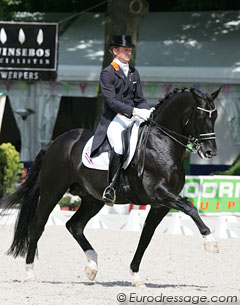 The combination traveled the ring focused with a nice soft contact with the bit. The test begun with good extended trots in which Gal seemed to push a little less for power in order to get more overtrack and prevent the front leg from clawing too much. The first extension was still exaggerated, then there was a tiny loss of rhythm in the second one but third was super. The nitty-gritty problem in the entire ride was the slight built-up of tension in the piaffe as Totilas seemed to quicken the tempo right before the exit into passage, but Gal did a great job staying relaxed in the saddle so Totilas made no huge leaps forward like he did at the World Cup Finals.
The combination traveled the ring focused with a nice soft contact with the bit. The test begun with good extended trots in which Gal seemed to push a little less for power in order to get more overtrack and prevent the front leg from clawing too much. The first extension was still exaggerated, then there was a tiny loss of rhythm in the second one but third was super. The nitty-gritty problem in the entire ride was the slight built-up of tension in the piaffe as Totilas seemed to quicken the tempo right before the exit into passage, but Gal did a great job staying relaxed in the saddle so Totilas made no huge leaps forward like he did at the World Cup Finals.
The second passage could have been a bit more regular, though there still was major bounce. The tempi changes were ground covering and especially the ones were straight. As Totilas explodes with expression, Gal seems to produce his best rides when he aims for less and keeps everything cool, calm and collected instead of scraping the bottom of the barrel. In Rotterdam the pair pulled it off perfectly and there was no doubt about his first place.
Hanging on for Dear Life
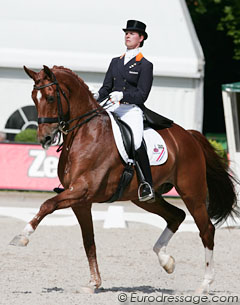 Holland's number two rider Adelinde Cornelissen (sometimes number one) finished second with a very generous 78.480%. There is no doubt about the world class athleticism and quality of the Dutch warmblood Parzival (by Jazz), but the duo's Grand Prix in Rotterdam just didn't taste as sweet as the rides they used to have the year before. Throughout the ride the sympathetic Cornelissen was hanging onto the curb for dear life. The long legged Parzival always has that graceful, elegant look and his trot extensions were huge and engaged, but the rider is leaning into the reins pulling the curb almost horizontally. The half pass right was a bit hurried, the one to the left was wonderful. The extended walk was super but the collected one rushed.
Holland's number two rider Adelinde Cornelissen (sometimes number one) finished second with a very generous 78.480%. There is no doubt about the world class athleticism and quality of the Dutch warmblood Parzival (by Jazz), but the duo's Grand Prix in Rotterdam just didn't taste as sweet as the rides they used to have the year before. Throughout the ride the sympathetic Cornelissen was hanging onto the curb for dear life. The long legged Parzival always has that graceful, elegant look and his trot extensions were huge and engaged, but the rider is leaning into the reins pulling the curb almost horizontally. The half pass right was a bit hurried, the one to the left was wonderful. The extended walk was super but the collected one rushed.
Both in the piaffe and passage Parzival was pulling his hocks high instead of moving the hind legs under the body. In the second piaffe he was croup high and there was absolutely no sit despite the fact that he is able to keep a clean rhythm with good suspension. The one tempi's were delightful and the extended canter was so energetic that the chestnut almost bolted. Adelinde needed several strides before she got him collected again.
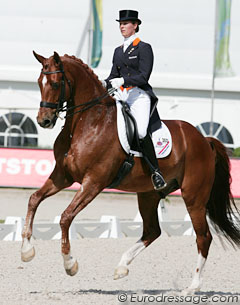 The final piaffe on the centerline was lovely but the passage between X and G was almost non existent as Parzival abandoned all collection and took off in a trot. The ride certainly had its highlights but it was far from being their best to date (e.g. Aachen 2008, Windsor 2009). The scores, however, strangely reflected absolute brilliance.
The final piaffe on the centerline was lovely but the passage between X and G was almost non existent as Parzival abandoned all collection and took off in a trot. The ride certainly had its highlights but it was far from being their best to date (e.g. Aachen 2008, Windsor 2009). The scores, however, strangely reflected absolute brilliance.
It is surprising to ascertain that when either Gal or Adelinde enter the ring the judges seem to have a whole different scale of points up their sleeve. Yes these riders both have extraordinary horses, but many more FEI top ranked riders enter-halt-salute for a 10, have trot extensions or piaffes and passages for 9's or 10's but they hardly seem to get those marks (several years ago the same score inflation happened to prima donna's Anky van Grunsven and Isabell Werth). Is this an emotive reaction to the halo effect of champions? This is not a plea to pull their scores down -- not at all -- but maybe one to raise those of other riders who ride (almost) equally well.
Sky is Not the Limit for "Sun"rise and "Stern"taler
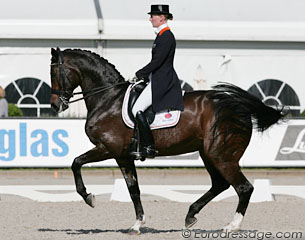 The third spot on the ranking was covered by another Dutchman: Imke Schellekens Bartels aboard the Smarius family's Hanoverian mare Sunrise (by Singular Joter). The pair was at their first show since finishing third at the 2010 World Cup Finals in 's Hertogenbosch, but there seemed no lack of routine. The control and elegance in the ride were probably the strong points, even more so than the execution of some movements. In piaffe and passage the regularity and smoothness were certainly there but the dark bay lacked engagement from behind in passage and should really take more weight on the hind quarters in the piaffe (though the second piaffe was sightly better, see photo). However, the canter work was excellent with great tempi changes, a wonderful left pirouette and a beautiful zig zag. It was a lovely ride that earned them 74.225%
The third spot on the ranking was covered by another Dutchman: Imke Schellekens Bartels aboard the Smarius family's Hanoverian mare Sunrise (by Singular Joter). The pair was at their first show since finishing third at the 2010 World Cup Finals in 's Hertogenbosch, but there seemed no lack of routine. The control and elegance in the ride were probably the strong points, even more so than the execution of some movements. In piaffe and passage the regularity and smoothness were certainly there but the dark bay lacked engagement from behind in passage and should really take more weight on the hind quarters in the piaffe (though the second piaffe was sightly better, see photo). However, the canter work was excellent with great tempi changes, a wonderful left pirouette and a beautiful zig zag. It was a lovely ride that earned them 74.225%
The highest ranking German was 25-year old Matthias Alexander Rath on Linsenhoff's Oldenburg gelding Sterntaler Unicef (by Sion x Manstein). The dark bay gelding has a funky conformation with a sagging back which makes him look as if he were glued together with two uni-coloured horse parts.
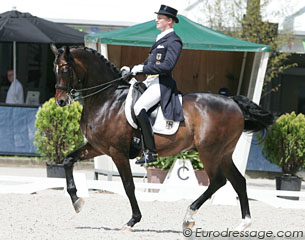 Nevertheless, this horse has a front and hind part that actually work together (unlike many Grand Prix horses). His trot extensions should score 11 because there can not be more engagement from behind with ground cover and relaxation at the same time. The half passes are super nice and the both the extended and collected walk are unrivalled. He has huge, straight tempi changes that should also earn him top notes. However, Sterntaler is a bit of an enfant terrible in the piaffe, terrorising his rider by threatening to explode (usually at X). Towards the end of the test some tension was crawling under Sterntaler's skin. He made an unscripted flying change in the corner after the extended canter and on the final centerline, he menaced his rider once more at X so Rath made the safe choice and did only 8 steps instead of the required 12 to 15.
Nevertheless, this horse has a front and hind part that actually work together (unlike many Grand Prix horses). His trot extensions should score 11 because there can not be more engagement from behind with ground cover and relaxation at the same time. The half passes are super nice and the both the extended and collected walk are unrivalled. He has huge, straight tempi changes that should also earn him top notes. However, Sterntaler is a bit of an enfant terrible in the piaffe, terrorising his rider by threatening to explode (usually at X). Towards the end of the test some tension was crawling under Sterntaler's skin. He made an unscripted flying change in the corner after the extended canter and on the final centerline, he menaced his rider once more at X so Rath made the safe choice and did only 8 steps instead of the required 12 to 15.
The panel of judges struggled to score Rath. In general the scoring was very harmonious with only slight differences, but Rath's ride posed a challenge. American judge Linda Zang scored his test a 76.383% while Belgian Jacques Van Daele had the pair at 70.426%. The others had him between 72 and 74%.
Liver Chestnuts Rank Fifth and Sixth
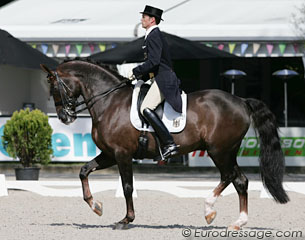 German Christoph Koschel and the liver chestnut Finnish warmblood Donnperignon (by Donnerhall x Mozart II) completed the top five with a 72.675%. The pair showed beautiful trot extensions with tons of ground cover and breath taking passage with a suspension that lasts seconds and outclasses some higher ranked horses. The 11-year old muscled gelding has a lovely silhouette but occasionally tends to go behind the vertical. In the second piaffe he whinnied which caused some tension but fortunately he maintained a great rhythm. Allround Donnperignon is a super talented dressage horse but Koschel's poor seat in some movements meddles with the gorgeous total image. The German has a nasty habit of not sitting still in the saddle in the piaffe. He's bumping and grinding his saddle to get the rhythm going and in the one tempi's changes he throws his weight from left to right like a weeble wobble. If he just were to sit still, his scores would go up another 2%!
German Christoph Koschel and the liver chestnut Finnish warmblood Donnperignon (by Donnerhall x Mozart II) completed the top five with a 72.675%. The pair showed beautiful trot extensions with tons of ground cover and breath taking passage with a suspension that lasts seconds and outclasses some higher ranked horses. The 11-year old muscled gelding has a lovely silhouette but occasionally tends to go behind the vertical. In the second piaffe he whinnied which caused some tension but fortunately he maintained a great rhythm. Allround Donnperignon is a super talented dressage horse but Koschel's poor seat in some movements meddles with the gorgeous total image. The German has a nasty habit of not sitting still in the saddle in the piaffe. He's bumping and grinding his saddle to get the rhythm going and in the one tempi's changes he throws his weight from left to right like a weeble wobble. If he just were to sit still, his scores would go up another 2%!
Hans Peter Minderhoud and Mr Kies' liver chestnut Dutch warmblood mare Nadine (by Partout) slotted in sixth with 72.644%. Their last show appearance was mid March in Dortmund and due to a minor injury they had to skip Den Bosch, but the mare was now back action. Minderhoud's heart rate did go up when his mare did not pass the vet check and had to be presented for re-inspection one hour before the Grand Prix (she passed with flying colours). All trouble set aside, Minderhoud will most likely grab Anky van Grunsven's vacant spot on the Dutch WEG team.
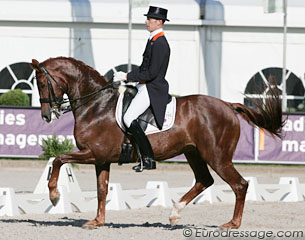 The semi-Trakehner bred mare has a flamboyant front leg use in the trot extensions but was more extravagant with her left front leg than the right one. The pair was searching for regularity in the half pass right and the transition to the half pass left was sloppy, but then got into the swing of things. The first piaffe was beautiful, the passage had a bit more activity right behind. In the second piaffe Nadine held her hindlegs stiffly and did not sit, but the rhythm was regular. There was some minor tension in the collected walk. The one and two tempi changes were absolutely brilliant. Minderhoud constantly had to ride his mare forward but still lost impulsion before the pirouette left. Though Nadine could have had more natural impulsion to generate an image of more lightness, her test was full of energy and expression.
The semi-Trakehner bred mare has a flamboyant front leg use in the trot extensions but was more extravagant with her left front leg than the right one. The pair was searching for regularity in the half pass right and the transition to the half pass left was sloppy, but then got into the swing of things. The first piaffe was beautiful, the passage had a bit more activity right behind. In the second piaffe Nadine held her hindlegs stiffly and did not sit, but the rhythm was regular. There was some minor tension in the collected walk. The one and two tempi changes were absolutely brilliant. Minderhoud constantly had to ride his mare forward but still lost impulsion before the pirouette left. Though Nadine could have had more natural impulsion to generate an image of more lightness, her test was full of energy and expression.
First Judging System Pilot in Rotterdam
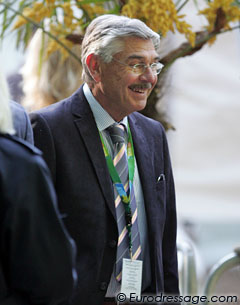 Rotterdam was the first official event where new judging systems were officially tested. The Grand Prix was judged by a panel of seven with two of them sitting in boxes on the short side at A. They all had telephones in their booth which linked to the Judging Supervisory Panel, which included David Hunt, Eric Lette and Uwe Mechlem. If the JSP felt the need to correct an unusual score of a judge, they rang the judge in question after the test and explained why they fixed a certain mark.
Rotterdam was the first official event where new judging systems were officially tested. The Grand Prix was judged by a panel of seven with two of them sitting in boxes on the short side at A. They all had telephones in their booth which linked to the Judging Supervisory Panel, which included David Hunt, Eric Lette and Uwe Mechlem. If the JSP felt the need to correct an unusual score of a judge, they rang the judge in question after the test and explained why they fixed a certain mark.
At the press conference after the Grand Prix, the judges were extremely happy about the JSP. "In soccer a referee also has linesmen assisting him. Now we have the same," Ghislain Fouarge explained. "Sometimes you can miss a movement because of the position where you are sitting at." Linda Zang agreed with Fouarge. "This is a good thing to happen," she said. "It was the first time we used the system and we were all wondering how it would work."
The supervisory panel acted on two occasions in the Grand Prix. The JSP called on Zang once. "One horse was one stride late in the zig zag and I missed it. I gave it a seven, but they took it down to a five." The other instance was with Rath's test. "There were not enough steps piaffe at X," Fouarge stated, adding that "some judges give it a five but the JSP corrected it to a 3."
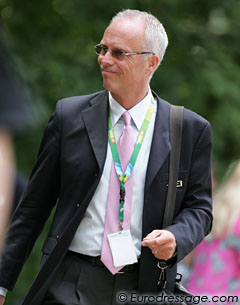 FEI Dressage director Trond Asmyr was very positive about the test pilot in Rotterdam. "This is bringing dressage closer to other sports," Asmyr said. "With the JSP we can always get away from the mistakes made by judges."
FEI Dressage director Trond Asmyr was very positive about the test pilot in Rotterdam. "This is bringing dressage closer to other sports," Asmyr said. "With the JSP we can always get away from the mistakes made by judges."
The system trials will continue in Aachen in a slightly different format. At the CHIO they want to test the effect of eliminating the communication between the JSP and the judges, because some judges find it disturbing to get interrupted after the ride. The half point system can only be tested in small tour level classes and the Grand Prix consolation class. "We noticed during the trials in Aachen in September 2009 that the half point system slightly pushes the scores higher. So this year we can only do the pilots with the half points on test, which doesn't influence the FEI Riders' Ranking," Asmyr told Eurodressage.
Asmyr disclosed that the results of the pilots will be reviewed at the 2010 General Assembly and the approved elements will be officially implemented in 2011, including at the European Championships and at 2012 Olympic Games.
More photos and commentary in the gallery below. There are 15 photos in the gallery and you can scroll the three pages by clicking on "1 of 3" below the gallery!!
Related Links
Scores 2010 CDIO Rotterdam
Ridderkerk Beats Dutch Champion Vontango in Rotterdam Prix St Georges